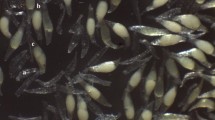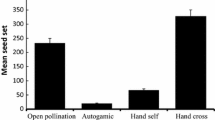Summary
Pollen movement is often restricted in natural populations, and insufficient pollination is a potential constraint on sexual reproduction in outcrossing species. Seed-set should decrease with increased distance from the pollen source in outcrossing plants. This prediction was tested using females of the clonal, gynodioecious herb Glechoma hederacea in three natural populations. In controlled pollinations, both hermaphrodites and females had similar high percentages of fruit-set and seed-set. In a natural population where a female clone was isolated from the nearest hermaphroditic clone by c. 100 m, fruit-set was low (1%). In another population where hemaphroditic clones were rare and female clones had a patchy distribution, fruit-and seed-set in females were pollen-limited and decreased with increased distance from the nearest pollen source. The estimated mean pollen dispersal distance was 5.9 m when calculated on fruit-set and 5.3 m when calculated on seed-set. The most frequent pollinators were bumblebees. The mean and median distances moved by pollinators between ramets were 0.13 m and 0.05 m. In a third population where female clones were isolated from the nearest hermaphrodites by more than 200 m, fruit-set was 0%. After introduction of 16 hermaphroditic ramets in the center of the female clone, fruit-set varied between 0% and 100% in individual female ramets. Fruit-set decreased with increased distance from the pollen source. The mean and median pollen movement distances were 1.06 m and 0.54 m.
Similar content being viewed by others
References
Andersson S (1988) Size-dependent pollination efficiency in Anchusa officinalis (Boraginaceae): causes and consequences. Oecologia 76:125–130
Arroyo MTK (1976) Geitonogamy in animal pollinated tropical angiosperms. A stimulus for the evolution of self-incompatibility. Taxon 25:543–548
Barrett CH, Thomson JD (1982) Spatial pattern, floral sex ratios, and fecundity in dioecious Aralia nudicaulis (Araliaceae). Can J Bot 60:1662–1670
Bateman AJ (1956) Cryptic self-incompatibility in the Wallflower: Cheiranthus cheiri L. Heredity 10:257–261
Bawa KS (1980) Evolution of dioecy in flowering plants. Ann Rev Ecol Syst 11:15–39
Carpenter FL (1976) Plant-pollinator interactions in Hawaii: Pollination energetics in Metrosideros collina (Myrtaceae). Ecology 57:1125–1144
Charlesworth B, Charlesworth D (1978) A model for the evolution of dioecy and gynodioecy. Amer Nat 112:975–997
Ehrlich PR, Raven PH (1969) Differentiation of populations. Science 165:1228–1232
Ellstrand NC, Marshall DL (1985) Interpopulation gene flow by pollen in wild radish, Raphanus sativus. Am Nat 126:606–616
Gill LS (1979) Cyto-taxonomic studies of the tribe Nepeteae (Labiatae) in Canada. Genetica 50:111–118
Godley EJ (1979) Flower biology in New Zealand. New Zealand J Bot 17:441–466
Gouyon P-H, Couvet D (1987) A conflict between two sexes, females and hermaphrodites. In Sterns SC (ed) The evolution of sex and its consequences. Birkhäuser Verlag, Basel, pp 245–261
Govindaraju DR (1988) Relationship between dispersal ability and level of gene flow in plants. Oikos 52:31–35
Handel SN (1985) The intrusion of clonal growth patterns on plant breeding systems. Amer Nat 125:367–384
Harberd DJ (1967) Observation on natural clones of Holcus mollis. New Phytol 66:401–408
Hessing MB (1988) Geitonogamous pollination and its consequences in Geranium caespitosum. Amer J Bot 75:1324–1333
Hicks DJ, Wyatt R, Meagher TR (1985) Reproductive biology of distylous Partridgeberry, Mitchella repens. Amer J Bot 72:1503–1514
Krohne DT, Baker I, Baker HG (1980) The maintenance of the gynodioecious breeding system in Plantago lanceolata. Am Midl Nat 103:269–279
Levin DA (1981) Dispersal versus gene flow in plants. Ann Missouri Bot Gard 68:233–253
Levin DA (1984) Immigration in plants: An exercise in the subjunctive. In: Dirzo R, Surukhan J (eds) Perspectives on plant population ecology. Sinauer, Sunderland, Mass, pp 242–260
Levin DA, Kerster HW (1974) Gene flow in seed plants. Evol Biol 7:139–220
Lewis D (1941) Male-sterility in natural populations of hermaphrodite plants: The equilibrium between females and hermaphrodites to be expected with different types of inheritance. New Phytol 40:56–63
Lloyd DG (1974) Theoretical sex ratios of gynodioecious angiosperms. Heredity 32:11–34
Meagher TR (1986) Analysis of paternity within a natural population of Chamaelirium luteum. 1. Identification of most-likely male parents. Am Nat 128:199–215
Menges ES (1987) Biomass allocation and geometry of the clonal forest herb, Laportea canadensis: Adaptive responses or allometric constraints. Am J Bot 74:551–563
Rathcke B (1983) Competition and facilitation among plants for pollination. In: Real L (ed) Pollination biology. Academic Press, Orlando, pp 305–329
Slade AJ, Hutchings MJ (1987) The effects of nutrient availability on foraging in the clonal herb Glechoma hederacea. J Ecol 75:95–112
Slade AJ, Hutchings MJ (1989) Within-and between-population variation in ramet behaviour in the gynodioecious clonal herb, Glechoma hederacea (Labiatae). Can J Bot 67:633–639
Slatkin M (1985) Gene flow in natural populations. Ann Rev Ecol Syst 16:393–430
Valdeyron G, Dommee B, Valdeyron A (1973) Gynodioecy: Another computer simulation model. Am Nat 107:454–459
Van Damme JMM, Van Delden W (1984) Gynodioecy in Plantago lanceolata L. IV. Fitness components of sex types in different life cycle stages. Evolution 38:1326–1336
Willson MF, Miller LJ, Rathcke BJ (1979) Floral display in Phlox and Geranium: Adaptive aspects. Evolution 33:52–63
Wyatt R, Hellwig RL (1979) Factors determining fruit-set in heterostylous bluets, Houstonia caerulea (Rubiaceae). Syst Bot 4:103–114
Author information
Authors and Affiliations
Rights and permissions
About this article
Cite this article
Widén, B., Widén, M. Pollen limitation and distance-dependent fecundity in females of the clonal gynodioecious herb Glechoma hederacea (Lamiaceae). Oecologia 83, 191–196 (1990). https://doi.org/10.1007/BF00317751
Received:
Accepted:
Issue Date:
DOI: https://doi.org/10.1007/BF00317751




